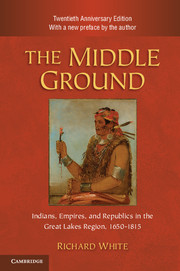Book contents
- Frontmatter
- Contents
- List of abbreviations
- Preface to the twentieth anniversary edition
- Introduction
- 1 Refugees: a world made of fragments
- 2 The middle ground
- 3 The fur trade
- 4 The alliance
- 5 Republicans and rebels
- 6 The clash of empires
- 7 Pontiac and the restoration of the middle ground
- 8 The British alliance
- 9 The contest of villagers
- 10 Confederacies
- 11 The politics of benevolence
- Epilogue: Assimilation and otherness
- Index
10 - Confederacies
Published online by Cambridge University Press: 05 June 2012
- Frontmatter
- Contents
- List of abbreviations
- Preface to the twentieth anniversary edition
- Introduction
- 1 Refugees: a world made of fragments
- 2 The middle ground
- 3 The fur trade
- 4 The alliance
- 5 Republicans and rebels
- 6 The clash of empires
- 7 Pontiac and the restoration of the middle ground
- 8 The British alliance
- 9 The contest of villagers
- 10 Confederacies
- 11 The politics of benevolence
- Epilogue: Assimilation and otherness
- Index
Summary
There is no need to discard theoretically all conceptions of “cultural” difference, especially once this is seen as not simply received from tradition, language, or environment but also as made in new political-cultural conditions of global relationality.
James Clifford, The Predicament of CultureKnowing by hindsight that the United States became a powerful state and that the Algonquians suffered defeat, death, and eventual removal, it is easy to misunderstand the complexity of their confrontation along the Ohio between 1785 and 1795. It is even easier to miscategorize the political units that confronted each other there. The conflict along the Ohio always remained, in part, a village conflict; but it was only partially a conflict of villages, because larger political units were forming on both sides. Until 1788 the American state consisted only of the Congress convened under the Articles of Confederation. The Indian confederation first took hazy shape at Sandusky in 1783. The Americans understood the confederation to be an alliance of tribes, but tribes in the pays d'en haut were less meaningful as political than as ethnic units. The identity of Algonquians as Shawnees, Delawares, or Weas influenced their actions and political loyalties just as the identity of backcountry settlers as Scots-Irish, Germans, or Anglo Americans influenced their actions. But this did not mean that the Weas, Shawnees, and Delawares acted as unified political entities any more than the Scots-Irish, Germans, and Anglo Americans formed unified and independent political groups.
- Type
- Chapter
- Information
- The Middle GroundIndians, Empires, and Republics in the Great Lakes Region, 1650–1815, pp. 413 - 468Publisher: Cambridge University PressPrint publication year: 2010

